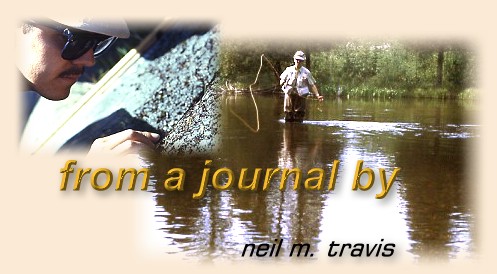Nearenuf
By Neil M. Travis, Montana/Arizona
At some point in the evolution of every fly fisher, especially those
anglers who use flies to catch trout, the angler will, consciously or
subconsciously, develop a theory about imitations. There are
several theories surrounding fly selection from the chuck and
chance it school to the match the hatch down to the last detail
group. Somewhere in that mélange you will find a home.
The logistics of developing a theory of imitation can be as
complex or simple as the personality of the angler who is
developing the theory. Case in point is the 'Nearenuf' pattern.
JC wrote a fly-tying article in FAOL back in 1998 describing
a fly called 'The Nearenuf.' This was a fly that we used back
on the Au Sable River in Michigan during our 'salad days' in
the early 60's. It was during this time period that JC and I were
just beginning to develop our own theory of insect imitation as it
related to tying flies to catch trout. The Nearenuf [near enough to
work] pattern is a very generic pattern that has a broad spectrum
appeal. As described in that article the basic fly consists of two
split tails, peacock quill body, upright wings, and dark ginger and
grizzly hackle. Tied in a variety of sizes it could and did imitate a
number of different mayflies that where present during the season
on the Au Sable. However, there were a number of insects that it
did not imitate, and it was only just marginally 'near enough' for
many other insects. We needed and wanted something more.
Given my 'scientific' bent I was more interested in imitations that
at least had the general impression of looking like the fly that I
was hoping to imitate. Near enough was not good enough.
At this juncture some anglers move in the direction of exact imitation.
They set out to attempt to duplicate exact replicas of the insects
complete with the precise number of legs, body segments, and
wing venation. In addition to being very time consuming and difficult
to tie these beautiful imitations rarely prove to be very successful
when put to use. Being more or less a lazy fly-tyer I chose not to
pursue this theory of imitation.
During this developmental stage JC and I chanced upon the
writings of Vince Marinaro. Vince proffered the theory, backed
up by sound scientific experimentation and practical field experience
that trout 'key' on specific insects based on their footprint as seen
from below. Soon JC and I were staring at live insects and our
imitations from the trout's vantage point. The results were truly
enlightening, but unfortunately tying patterns that imitate the
footprint of flies on the surface proved nearly as daunting as
tying exact imitations. Once again we were back to the
drawing board.
About this time our friends Swisher and Richards published
their landmark book Selective Trout. They
introduced an entirely different theory of imitation — get rid of
the hackle or tie it parachute-style, use a single clump wing,
or tie duck quill wings on the side of the fly, use widely spread
tails, and put the entire body of the fly on the surface. Wow,
that was a radical departure from every standard fly-tying
method that was used at that time, but it worked!
Swisher and Richards theory combined the scientific approach
of matching the size and color of the insect with the near enough
theory concerning how the insect looked on the surface. While
not the perfect answer to imitation it came closer than most
previous ideas.
From these various theories and years of experience on a
variety of trout waters my own personal theory and practice
of insect imitation is an eclectic collection of various methods.
Given the fact that I have the enviable ability to regularly fish
some of the finest trout waters in the world, and to rub shoulders
with some of the finest trout anglers has given me a unique insight
into what works. The reality of the situation dictates that, excluding
the tying of exact imitations, a mix of tying methods from the
Marinaro style to the Swisher-Richards method produces the
most consistent results. Thus my fly boxes contain the old
standard hackle patterns, no hackle and parachute patterns,
and a few Marinaro-style criss-cross hackle patterns for those
times when nothing else will do.
I tie my flies to imitate specific hatches looking first at size and
then at color. I attempt to capture the overall impression of the
live insect, and then to present it to the trout as naturally as
possible. I don't worry about the number of legs or tails that
my imitation may appear to have since I don't believe that
trout either can count or have the time to do so during that
split second period when they must decide to eat or reject
my imitation.
My theory of imitation is based on the belief that trout are
neither intelligent nor stupid, but that they are creatures that
have been molded by the environment in which they live. To
thrive in their environment they must learn to recognize food
items based on several different criteria, which varies markedly
over the course of the season. My imitations ability to replicate
both the appearance and behavior of their prey will determine
my success in fooling them into accepting my imitation as food.
My offering will never exactly look like a living, breathing insect,
and I guess that in the final analysis all of our offerings are just
near enough. ~ The Chronicler
From A Journal Archives
|

